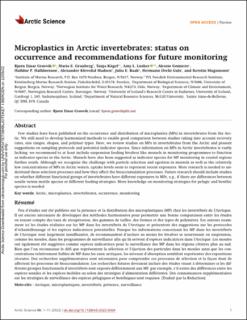| dc.contributor.author | Grøsvik, Bjørn Einar | |
| dc.contributor.author | Granberg, Maria E. | |
| dc.contributor.author | Kögel, Tanja | |
| dc.contributor.author | Lusher, Amy | |
| dc.contributor.author | Gomiero, Alessio | |
| dc.contributor.author | Halldorsson, Halldor P. | |
| dc.contributor.author | Madsen, Alexander Klevedal | |
| dc.contributor.author | Baak, Julia E. | |
| dc.contributor.author | Guls, Hermann Dreki | |
| dc.contributor.author | Magnusson, Kerstin | |
| dc.date.accessioned | 2023-03-23T10:36:00Z | |
| dc.date.available | 2023-03-23T10:36:00Z | |
| dc.date.created | 2022-10-03T10:40:21Z | |
| dc.date.issued | 2022 | |
| dc.identifier.citation | Arctic Science. 2022. | en_US |
| dc.identifier.issn | 2368-7460 | |
| dc.identifier.uri | https://hdl.handle.net/11250/3060085 | |
| dc.description.abstract | Few studies have been published on occurrence and distribution on microplastics (MPs) in invertebrates from the Arctic. We still need to develop harmonised methods to enable good comparison between studies taking into account recovery rates, size ranges, shapes and polymer types. Here, we review studies on MPs in invertebrates from the Arctic and present suggestions on sampling protocols and potential indicator species. Since information on MPs in Arctic invertebrates is vastly lacking, we recommend to at least include suspension feeding bivalves like mussels in monitoring programmes to function as indicator species in the Arctic. Mussels have also been suggested as indicator species for MP monitoring in coastal regions further south. Although we recognise the challenge with particle selection and egestion in mussels as well as the relatively low concentrations of MPs in Arctic waters, uptake levels seem to represent recent exposures. More research is needed to understand these selection processes and how they affect the bioaccumulation processes. Future research should include studies on whether different functional groups of invertebrates have different exposures to MPs, e.g., if there are differences between sessile versus motile species or different feeding strategies. More knowledge on monitoring strategies for pelagic and benthic species is needed. | en_US |
| dc.description.abstract | Microplastics in arctic invertebrates- Status on occurrence and recommendations for future monitoring | en_US |
| dc.language.iso | eng | en_US |
| dc.publisher | Canadian Science Publishing | en_US |
| dc.rights | Navngivelse 4.0 Internasjonal | * |
| dc.rights.uri | http://creativecommons.org/licenses/by/4.0/deed.no | * |
| dc.title | Microplastics in arctic invertebrates- Status on occurrence and recommendations for future monitoring | en_US |
| dc.type | Peer reviewed | en_US |
| dc.type | Journal article | en_US |
| dc.description.version | publishedVersion | en_US |
| dc.rights.holder | © 2022 Authors | en_US |
| dc.source.pagenumber | 11 | en_US |
| dc.source.journal | Arctic Science | en_US |
| dc.identifier.doi | 10.1139/AS-2022-0004 | |
| dc.identifier.cristin | 2057721 | |
| dc.relation.project | Havforskningsinstituttet: 15517 | en_US |
| cristin.ispublished | true | |
| cristin.fulltext | original | |
| cristin.qualitycode | 1 | |

